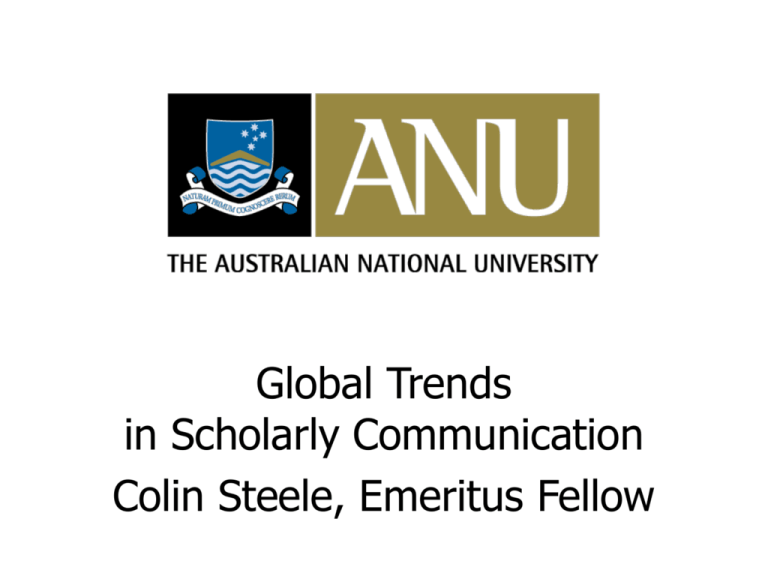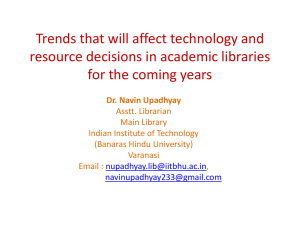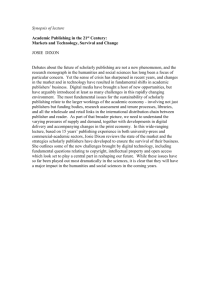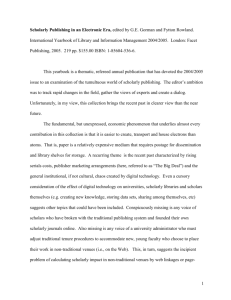The UK Research that - Melbourne's Scholarly Information Future
advertisement

Global Trends in Scholarly Communication Colin Steele, Emeritus Fellow Structure of the Talk Overview : Strategic ICT frameworks for information provision in the twenty-first century How do we define the digital campus? UK / US inputs April - May 2005 Teaching and Learning and Research issues Scholarly communication futures and digital information structures Dr Evan Arthur: DEST. APSR May 2005 $5b expended annually by the Government on R&D Government increasingly convinced high quality research results depend on appropriate infrastructure – including datasets, data outputs, disparate data holdings and getting better access to highly processed data and articles Dr Evan Arthur 2 Issues for scholarly publishing: costs of access and new methods of publishing scholarly impacts before form of publication role of institutional and discipline repositories and how to populate them are the players talking to each other, eg librarians and grid people? (what about scholars and the Academies?) Dr Evan Arthur 3 “The digital revolution is disaggregating the traditional process of publishing” but Maybe better to state it has the potential to? Since large sectors of the academic community seem unaware of issues ? Scholars separated from economics of scholarly communication and “driven” by RQF frameworks and publishing conservatism ? Oxford Internet Institute “Few scholars of information studies to look to help” ( Professor William Dutton) Increasingly complex issues over data mining, archiving, data curation, search engines, etc Need to mesh research activities and collaborations with communication technologies Seamless access for user-driven information seeking Digital scholarly communications lines blurred The World is Flat What are the global digital challenges?: Acceleration of print to digital and then selectively back to print output Greater specificity and personalisation and ease and speed of access Increasing user expectations of “free” material Flat rather than vertical ICT structures needed Columbia University Information Services Organization UNIVERSITY LIBRARIES CENTER FOR NEW MEDIA TEACHING AND LEARNING DIGITAL KNOWLEDGE VENTURES OFFICE OF IT RESEARCH AND DEVELOPMENT ACADEMIC INFORMATION SYSTEMS ELECTRONIC PUBLISHING INITIATIVES COPYRIGHT ADVISORY OFFICE OFFICE OF IT POLICY AND PLANNING Current E Landscapes Publishers Communication Group, Global Electronic Collection Trends in Academic Libraries: “84% of respondents reported their institution cancelled print when e-content available” Access at the desktop by most scholars Increasing reliance by scholars on library subs and/or personal networks via email, RSS, etc Research libraries: “one foot on the dock and one in the dinghy”! MIT Libraries 2004 Annual Report Library as Place? Information and Learning Commons Professor Diana Oblinger, ‘Educating the Net Generation’ http://www.educause.edu/content. The changing nature of the library as place ‘Libraries occupy prime spots on campus – but are they the best place to store millions of books, given the new roles of libraries’ (Jim Neal CIO Columbia University) Library Space: Museum or Mall? “Paper content is being moved offsite to make room for things like cafes and information commons, but what stays and what goes? We do not have good tools for these decisions.” OCLC “The idea of the balanced—but unread— collection is disappearing.” Strategic Issues for Columbia University include: Distributed electronic access to content, tools and services High quality physical and electronic spaces Innovative applications of technology to support teaching and research High quality infrastructure integrated into the academic fabric of the university Alicia Wise CEO UKPLS Key strategic challenge for information professionals is “that many involved in shaping the future of e-Learning do not see the relevance of content nor services” Rebranding needed to transform “library” and “published” content into “learning tools” IT enables but does not drive pedagogy E-learning Futures Better evaluation, training and reward systems to create more “engaged “ learning and learning spaces - Columbia CNMTL experience Future use of online simulations, wireless technologies and reusable content objects (Kim and Bonk ‘The future of workplace e-learning” in Handbook of Blended Learning http://www.publicationshare.com/c083_bonk_future. pdf ) E Frameworks JISC DEST e-framework 12 July 2005 “Breakdown monolith VLE’s into core components –authentication, authorisation, course management, assessment, marketing, tracking and content management” www.e-framework.org “Learning is the issue - e is simply a mechanism” (Hawkins and Oblinger. Educause Review July/August 2005) The Google Generation-Chips With Everything “Uni isn’t what uni was: it’s a case now of going to lectures and tutorials and buggering off to McDonalds to cook chips” Ian Dobson, Senior Research Fellow, Monash University What do the “chip generation” think, want and do? –not necessarily the same things! Impact on students and staff of Google, Google Scholar and Google Print Science Publishing Trends The rise and rise of science serial publishing multinationals – science publishing fastest growing media sub sector in past fifteen years Elsevier huge expansion 1970 to 2005 plus 2004 gross profit over one billion pounds Trends now the same in SS and Humanities Impact on book votes - annual rise 2006 - 5 % pa Elsevier, 8% Blackwell- “certainty for libraries”! Extant journal titles, 1665-2001 Source: Elsevier Science 15000 Data from Ulrich ’s International Periodicals Directory on CD-ROM Summer 2001 Edition 10000 5000 0 1665 1765 1865 1965 James O’Donnell Provost of Georgetown University: the journal is a seventeenth century device, tweaked by the nineteenth, extended consistently in the twentieth at greater and greater cost and now hopped up on network amphetamines! If starting afresh would be dynamic, digital with open peer review Cutting The Scholarly Mustard? Caroline Michel (Harper Press) March 3, 2005: “Guardian World Book Day Forum” “Mr Colman said that he made his fortune not from the mustard people ate, but from the mustard that remained on the side of the plate when the meal was finished” Comparison here with most academic articles relatively little read, little used and little needed except for RQF’s ? Academic Dross? 30% of titles from Big Deal publishers account for 80% of articles downloaded (Gatten and Sanville, D-Lib magazine) “Simon Mays-Smith (Credit Suisse First Boston) “Does More Access Mean Less Library?” (UKSG April 2005) – most useage from relatively few high cost journals - NESLI 2005 stats Fighting Over The Academic Body. Librarians and Publishers Elsevier Research : Author Priorities: Michael Mabe 2= 1 6 QUALITY & SPEED 5 7 8 4 2= Data from 36,188 Authors; 0= unimportant 10= very important Reward Systems: The Key To Scholarly Change RAEs and University League Tables still the “fatal attraction” ( Professor A J van Raan - Leiden ) Issues arising from UK RAE and OZ RQF’s Peer review can disadvantage new disciplines, applied and interdisciplinary research New CHASS metrics August 2005 How do you measure a multidimensional ”research library in a box”… as follows? Professor Edward Ayers Virginia New Forms Of Historical Dialogue? Role and Function of Institutional Repositories IR’s preserve and make available globally institutional digital assets - new models of scholarship (Abby Smith Director CLIR) Repositories will be increasingly important for institutional scholarship frameworks IR’s intersect digital libraries, e -research, teaching and learning, courseware, records management, preservation and RQF issues Institutional Repositories University of California CDL : “source of knowledge that should be shared with society” … (Catherine Candee) 1.2 million downloads California E Scholarship in less than 2 years – 98 per cent outside the institution Dutch “Cream of Science” deposit - 41,000 pubs by top 206 researchers- website overloaded on first day-0.5 million hits APSR ARROW Project Open Access Issues http://eprints.unimelb.edu.au/. Melbourne Terminologies often confusing, eg “Author Pays, Open Access, and Institutional Repository” 81 % of UK researchers would comply with employer or funder mandate to deposit copies in IR’s - further 14% reluctantly. (Alma Swan- Key Perspectives May 2005) The Worm Turns? Ayris (UKSG 2005): University College London faculty mandates, links to Research Office and citations etc UCL Embryonic principle of cost recovery of academic time for commercial publications? Public good campus input- library and IT infrastructure Public good campus output - Press and I.R Campus Budget Changes? What about the hidden costs in terms of campus infrastructure and time of the academic community in editorial board activities, refereeing, etc for the major international STM publishers? Sally Morris ”The True Costs of Scholarly Journal Publishing” April 2005 – us$100,000 per article if all costs considered New Strategies on Campus? “Presidents, Provosts, Deans, Scholars, Librarians and Technologists together must find ways within the larger academic community for their institutions to work together to realise the extraordinary economies of scale that are possible” to effect “new modes of ongoing operation” Managing Digital Assets, Donald Waters, http://www.clir.org/activities/registration/feb05_s pkrnotes/waters.htm Monograph Trends Books will be deconstructed in the digital ageGoogle Print, Amazon within the Book Books and chapters metadata and full text searchable - increasing commercial slices eg OUP Print runs decline dramatically from 3,000 plus copies per monograph in the 1960s to less than 300 by 2004 ( British Academy May 2005) Professor J. B. Thompson ‘Books in the Digital Age’ Polity 2005- role of MUP? POD and BACK TO THE FUTURE - STARBUCKS? New University E Presses ANU E Press Downloads 2005 Still early days, but figures impressive for downloads in 2005 of 14 reprint academic titles PDF complete book and chapter downloads55,000 to date Eg Oskar Spate ‘Spanish Lake’ 10,045 pdf’s Book is physical symbol of tenure so who cares re global access? Professor Blaise Cronin “Mickey Mouse and Milton”April 2004 US AAUP and SSP June 2005 “Authors want their content free online with chapters available in digital reserves for student use BUT Also want royalty advances, hardcopy production and at the end of the day ‘why have you sold so few copies of my book’ “ Books replicate serials in scholarly dialogue disengagement? Richard Gedye: OUP – Knowledge Functions Funding it Doing it Validating it Distributing it Marketing it Discovering it Reading it Preserving it Citing it FUNDER AUTHOR INTERMEDIARY INTERMEDIARY INTERMEDIARY INTERMEDIARY READER INTERMEDIARY READER/INTERMEDIARY US Faculty Senate Resolutions 2005 Many resolutions from US universities March to May 2005 as a result of the ‘serial crisis’ Equates to Pearl Harbour? Came to the war late, but can’t win the (serial) war without them ! US resolutions: All focus on the principle of Open Access to enhance institutional scholarly research New models of scholarly publishing consistent with standards of peer review and scholarly excellence AND acceptance by RQF’S in OZ Open access increases impact Citation rates for OA articles are up to five times greater Key Perspectives Ltd PNAS:Open Access Uptake Diane Sullenberger, ALPSP 8 April 2005 PNAS Subject Classification Genetics Neuroscience Microbiology Chemistry Statistics % Articles Open Access 21% 19% 18% 8% 0% Australian ARIIC Framework Australian government encouragement of institutional knowledge frameworks Australian Research Information Infrastructure Committee OA framework: Building the infrastructure, such as IR’s , that will advance open access Raising awareness of the principles and practice of open access publishing within Australian research institutions GO8 VC’S Statement 2004 Information if it is to achieve maximum benefit for society must be readily available New business models are required to ensure that scholarly publishing is cost effective But what was the collective impact of these on G08 academic communities? Little attention to dissemination of results of research - Birdsall Canadian recommendations Russell Group June 2005 Publicly-funded research should be publicly available. (nb over 90% of UK university research is publicly funded - Wellcome Trust ) The current system of scholarly publishing does not always work in the best interests of the research community. Institutions to support the development of I.R’s and actively encourage their researchers to deposit their work in them. RCUK June 28 statement “The UK Research Councils argue that technology offers new possibilities to communicate the results of research, through developments in electronic publishing such as open access journals and e-print repositories” RCUK 2 “Ideas and knowledge derived from publicly-funded research must be made available and accessible for public use, interrogation, and scrutiny, as widely, rapidly and effectively as practicable. The models and mechanisms for publication and access to research results must be both efficient and cost-effective in the use of public funds.” Possible Futures Improve the current models What is the SC future? Might it be completely different? Reform, revolution or the third way? Seen in evolution of RCUK policy Is it possible to model a transitional path for Australia ? Issues Summary • • • Research data is diverse and increasing Repository collections are thus dynamic Technical challenges include: interoperability, persistence, provenance, resource discovery and infrastructure • Embedding in workflow is critical: scholarly communications, research practice, elearning. Structure diagrams follow: Scholarly Interaction and Integrated Student/UCLA Instrumentation Collaborative Tools: -Whiteboards -Discussion -Calendar -Search Computational Resources Grid -Clusters -Supercomputers Instructor People: SAKAI Researcher Oracle Portal Pilot -Directories -Bios -Relationships Access Portals Datasets My.UCLA Repositories: -White Papers -Publications -Documents Dspace Student Public Rights & Roles, Affiliations, Relationship to Resource (Authentication, Shibboleth…) Limited Private Working Area: -Project Descriptions -Drafts -Annotation lab books PDAs campus portal learning management systems exhibitions course material text book personal collections reading lists user environments resource environment library Virtual reference Institutional repository Aggregations Digital collections E-reserve Catalog Cataloging ILL Licensed collections Conclusion Need shared campus understandings of emerging scholarly communication and information frameworks And the ICT architecture that is needed to support e-resources Need to develop such integrated information frameworks on campus otherwise… “Google” bypasses the Library? Thank You For Your Interest Scholar with His Books (1671) Gerbrand van den Eechhout (1621-1674)





